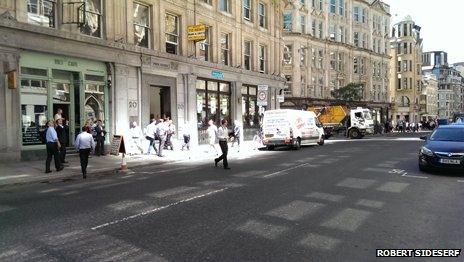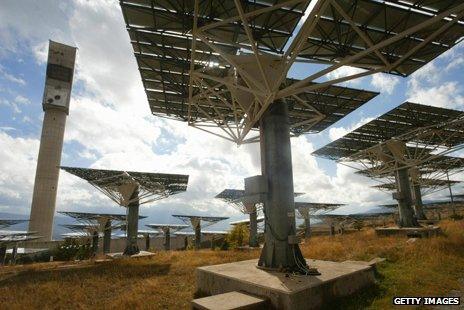Who, what, why: How does a skyscraper melt a car?
- Published
The BBC's Andrew Verity surveys the damage caused by the skyscraper
A London skyscraper dubbed the Walkie-Talkie has been blamed for reflecting light which melted parts of a car parked on a nearby street. What happened?
It's like starting a fire with a parabolic mirror.
"Fundamentally it's reflection. If a building creates enough of a curve with a series of flat windows, which act like mirrors, the reflections all converge at one point, focusing and concentrating the light," says Chris Shepherd, from the Institute of Physics.
The half-finished 37-storey "Walkie Talkie"- nicknamed such because of its tapering rectangular design - is indeed a curvy building. Its design, which has also been compared to a brimming pint glass, has provoked controversy before, external.
It transpires the car, a Jaguar on Eastcheap in the City of London, was parked at just the spot where the focused light landed.

The "hot spot" on Eastcheap, in London
The car wasn't the only casualty. There have also been reports of a smouldering bicycle seat, singed fabric and blistered paintwork.
Land Securities, which is developing the tower with the Canary Wharf Group, says it is working on a solution and has taken the emergency measure of suspending the parking bays beneath the glare.
They have described the problem as a phenomenon caused by the current elevation of the sun in the sky. It is thought it can last for two hours a day and might only be a problem for the next two or three weeks.
But how common is it for skyscrapers to damage cars or property in this way?
Architectural critic Jonathan Glancey says the story is not unprecedented.
In 2003, the opening of the Walt Disney Concert Hall in Los Angeles, designed by architect Frank Gehry, hit a similar stumbling block.
"The building was clad from head to toe, right down to the pavement, in stainless steel panels, and they would send the sun dazzling across the sidewalks to hotspots where people were. It was measured up to 60C (140F).
"Local people living there complained they were having to crank their air conditioning up to maximum to cool things down," he says.
Blinding glare also affected drivers passing the building.
After computer models and sensor equipment identified the panels causing the problem, they were sanded down to break up the sun's rays.
There are also plenty of lesser-known, smaller scale sun traps caused by architecture, according to Shepherd.
"The Eden shopping centre in High Wycombe has a shop with a series of windows in a curve that all happen to concentrate the light at one point. If you walk across that point you can feel some warmth," he says.
There are also those caused by design, rather than accident.
Solar furnaces, the largest of which is in Odeillo in France, use mirrors to gather sunlight and create high temperatures, usually for industry.
The temperature at focal points can reach 3,500C (6,330F), with the heat used for testing various materials, generating electricity and the design of solar plants.
Shepherd says the same principle is also used in reflecting telescopes. A curved mirror collects the light and reflects it to a focus.
"It has to be perfectly curved to get a clear picture - if not you get hazy blob concentrations," he says.
The physics is the same for sound as for light, he adds. "The curved mirror effect can be used to focus sounds - or the reverse, if a speaker stands at one end of an amphitheatre, and wants to project to an audience."

Solar furnace in the French Pyrenees
When it comes to the skyscraper and the car, Shepherd says the fact the car was black - a good absorber of light - would have had an impact on the damage caused by the concentrated heat.
He says the only parts that seem to have suffered are plastic, which is significant, as plastics generally have a much lower melting point than the steel of the car body.
Some plastics such as PVC - polyvinyl chloride - can melt at 100C, but they can soften before that. One reading taken today suggested the hotspot was 91.3C.
As for the Walkie-Talkie, Shepherd thinks the developers could employ a number of possible solutions.
"They could coat the windows to reduce reflection - which would be a cheap fix - but the downside of that is it could reduce the light entering the building.
"Another solution would be for them to misalign the window frames, to slightly alter them by about a millimetre, but that would be very expensive," he says.
You can follow the Magazine on Twitter, external and on Facebook, external